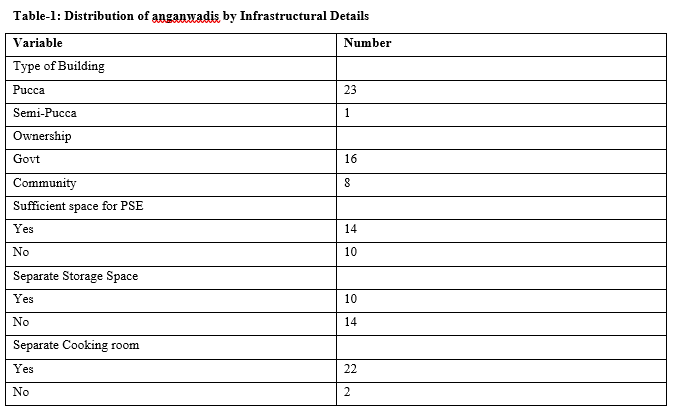Assessment of the anganwadi centres in the Urban Field Practice Area of Father Muller Medical College, Mangalore
Abstract
Background: Anganwadi centers are the focal units for the implementation of the Integrated Child Development Services projects in each block. Anganwadi centres cater to the children up to the age of 6 years, pregnant and lactating mothers, adolescent girls and women in the reproductive age group. There are 32 anganwadi centres in the Mullerkad-Jyothinagar urban field practice area of Father Muller Medical College, Mangalore. Under the public private partnership model our institution provides immunization, health education, health check –up and referral services to these anganwadi centres.
Objective: To assess the infrastructural facilities of the anganwadis and quality of services provided.
Methodology: Study design: Cross Sectional; Study area: Field practice area of UTHC Mullerkad-Jyothinagar, Father Muller Medical College, Mangalore; Sample size: 24; Study duration: March 2013-June 2013; Data collection tool: Interview schedule cum observation checklist.
Results: 9 of anganwadi workers were educated up to SSLC. Most of the anganwadi workers were residing within 15 minutes distance of the respective anganwadi centres. Registers were maintained properly and kept updated in all the anganwadis. 10 anganwadi were not having separate space of storage and 3 did not have even toilet facility available. Cooking area was separate in most of the anganwadis 14.
Conclusion: Basic amenities like space for storage, kitchen and toilet and playing area for the children should be there in all the anganwadis. Pregnant and lactating mothers should be followed up to confirm whether they have been registered at any health centre and have received the requisite number of IFA and TT doses.
Downloads
References
2. Chainani N, Sharma P, Meena N, Sharma U. Pattern of vitamin deficiencies among the malnourished preschool children in ICDS blocks of Jaipur city. Indian J Matern Child Health. 1994 Oct-Dec;5(4):109-11.
3. Arun Gupta and Jon E Rohde, Infant and Young Child Under Nutrition, Economic and Political Weekly(2004).
4. Patil SB, Doibale MK. Study of profile, knowledge andproblems of Anganwadi workers in ICDS blocks: A crosssectional study. Online J Health Allied Sci 2013;12:1. Availablefrom: http://www.ojhas.org/issue46/2013-2-1.html. [Lastaccessed on 2015 Aug 28].
5. Agarwal KN, Agarwal DK, Agarwal A, Rai S, Prasad R, Agarwal S, Singh TB. Impact of the integrated child development services (ICDS) on maternal nutrition and birth weight in ruralVaranasi. Indian Pediatr. 2000 Dec;37(12):1321-7.
6. Saiyed F, Seshadri S. Impact of the integrated package of nutrition and health services. Indian J Pediatr. 2000 May;67(5):322-8.
7. Kapil U, Pradhan R. Integrated Child Development Services scheme (ICDS) and its impact on nutritional status of children in India and recent initiatives. Indian J Public Health. 1999 Jan-Mar;43(1):21-5.
8. Bhasin SK, Bhatia V, Kumar P, Aggarwal OP. Long-term nutritional effects of ICDS. Indian J Pediatr. 2001 Mar;68(3):211-6.
9. Trivedi S, Chhaparwal BC, Thora S. Utilization of ICDS scheme in children one to six years of age in a rural block of central India. Indian Pediatr. 1995 Jan;32(1):47-50.
10. National Family Health Survey, India 2005-06. (NFHS 3)Mumbai: International Institute for Population Science and Macro International; 2007.
11. Dongre AR, Deshmukh PR, Garg BS. Perceived responsibilitiesof Anganwadi workers and malnutrition in rural Wardha. Online J Health Allied Sci 2008;7:3. Available from: http://www.ojhas.in/issue25/2008-1-3.htm. [Last accessed on 2015 Sep 15].
12. Chudasama RK, Patel UV, Verma PB, Vala M, Rangoonwala M, Sheth Aet al. Evaluation of Anganwadicentres performance under Integrated Child Development Services(ICDS) program in Gujarat State, India during year 2012 . JMahatma Gandhi Inst Med Sci. 2015 Jan;20(1):60-5.
13. Seema TN. Performance of Anganwadi centers in Kerala: An evaluation Experiment to develop a model centre with community participation" Discussion paper no. 28.2001, Kerala research programme on local level development studies, Tiruvananthapuram.ISBN no.81-87621-30-3.
14. Datta SS, Boratne AV, Cherian J, Joice YS, Vignesh JT, Singh Z.Performance of Anganwadicentres in urban and rural area: Afacility survey in Coastal South India. Indian J Matern ChildHealth. 2010 Oct-Dec;12(4):1-9.
15. Singh D, Gaur KL, Sharma MP. Performance evaluation of Anganwadi workers of Jaipur Zone, Rajasthan.International Journal of Engineering Science Invention. 2013 April; 2(4):28-34
16.Integrated Child Development Services (ICDS) Scheme, ChildDevelopment. New Delhi: Ministry of Women and ChildDevelopment, Government of India. Rapid Facility Survey ofInfrastructure at Anganwadi Centers (RFS-AWCs) by NCAER.Available from: http://wcd.nic.in/icds.htm. [Last accessed on2015 Jun 21].
17. Uttarakhand, Dept. Of Women and Child Development, ICDS Unit, Dehradun. (2007) - Community Based Monitoring System. Dehradun.Available from:http://nipccd.nic.in/reports/icdsvol3.pdf. [Last accessed on 2015 Sep 15]
18. Dash N.C. et Al. (2006) Bhubaneswar: Centre For Rural Development –ImpactAssessment/ Evaluation of ICDS Program in the State Of Orissa.Available from:http://nipccd.nic.in/reports/icdsvol3.pdf. [Last accessed on 2015 Sep 15]
19. Social Assessment of ICDS in Karnataka (2005). Bengalore: KAR-DWCD- IndianInstitute Of Management Bangalore, Bengalore.Available from:http://nipccd.nic.in/reports/icdsvol3.pdf. [Last accessed on 2015 Sep 20]
20. Chudasama RK, Kadri AM, Verma PB, Vala M, Rangoonwala M, Sheth A. Evaluation of nutritional and other activities atAnganwadi centers under integrated child development services programin different districts of Gujarat, India. J Med NutrNutraceut. 2015 Jul-Dec;4(2):101-6.
21. Baseline Survey for World Bank Assisted ICDS-III Project in Rajasthan (2000). Jaipur : IIHMR. Indian Institute Of Health Management Research, Jaipur.Available from:http://nipccd.nic.in/reports/icdsvol3.pdf. [Last accessed on 2015 Sep 20]
22. Sobha, I, Welfare Services For Women And Children. Tirupati : Sri PadmavatiMahilaViswaVidyalayam, Dept. Of Women's Studies.Available from:http://nipccd.nic.in/reports/icdsvol3.pdf. [Last accessed on 2015 Sep 20]
23. Singhi, N. K., Joshi, Varsha and Pal, Pritam. (1996) Strengthening Quality and Access toServices in ICDS Program: A Social Assessment. Jaipur: Institute Of DevelopmentStudies.Available from:http://nipccd.nic.in/reports/icdsvol3.pdf. [Last accessed on 2015 Sep 20]

Copyright (c) 2016 Author (s). Published by Siddharth Health Research and Social Welfare Society

This work is licensed under a Creative Commons Attribution 4.0 International License.


 OAI - Open Archives Initiative
OAI - Open Archives Initiative


